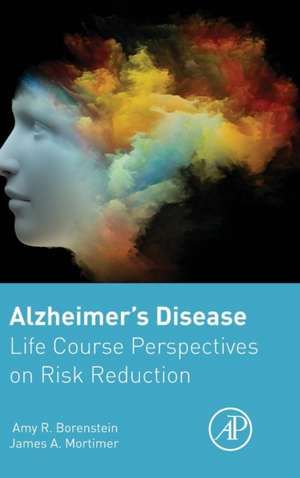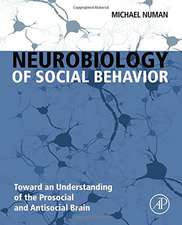Alzheimer's Disease: Life Course Perspectives on Risk Reduction
Autor Amy Borenstein, James Mortimeren Limba Engleză Hardback – 10 feb 2016
At the conclusion of the book, the reader will understand why Alzheimer’s disease likely begins at conception, then progresses through early-life and adult risk factors that ultimately impact the balance between pathologic insults in the brain and the ability of the brain to modify disease symptoms. In contrast to edited volumes that may have little cohesion, this book focuses on an integrated life-course approach to the epidemiology of dementia, in particular, Alzheimer’s disease.
- Reviews the current science surrounding Alzheimer’s disease
- Provides a primer of foundational knowledge on the disease's epidemiology and biostatistics
- Utilizes a life-course approach, providing a novel and integrated view of the evolution of this illness from genes to brain reserve
- Uses the ‘threshold model’—a theory first described by Dr. Mortimer and widely accepted today—which incorporates the idea of risk factors for the pathology and expression of the disease
- Proposes that improving brain health through modifiable behaviors can delay disease onset until a later age
- Examines the future of prevention of Alzheimer’s disease, a subject of great current interest
Preț: 420.33 lei
Preț vechi: 456.88 lei
-8% Nou
Puncte Express: 630
Preț estimativ în valută:
80.44€ • 87.35$ • 67.57£
80.44€ • 87.35$ • 67.57£
Carte tipărită la comandă
Livrare economică 15-29 aprilie
Preluare comenzi: 021 569.72.76
Specificații
ISBN-13: 9780128045381
ISBN-10: 0128045388
Pagini: 466
Dimensiuni: 152 x 229 x 28 mm
Greutate: 0.9 kg
Editura: ELSEVIER SCIENCE
ISBN-10: 0128045388
Pagini: 466
Dimensiuni: 152 x 229 x 28 mm
Greutate: 0.9 kg
Editura: ELSEVIER SCIENCE
Cuprins
Prologue: A Primer on Epidemiologic Concepts and MethodsSection 1. Defining a CaseChapter 1. The "First" CaseChapter 2. Clinical Appearance, Progression, and ClassificationChapter 3. Epidemiologic Definition of a CaseChapter 4. Neuropathology of Alzheimer's DiseaseChapter 5. The Threshold Model of DementiaSection 2. Descriptive EpidemiologyChapter 6. The Prevalence of Alzheimer's DiseaseChapter 7. The Incidence of Alzheimer's DiseaseChapter 8. Survival and Mortality in Alzheimer's DiseaseSection 3. Analytic EpidemiologyChapter 9. Introduction to the Analytic Epidemiology of Azheimer's DiseaseChapter 10. Family History, Genetics, and Down Syndrome Chapter 11. Early-Life FactorsChapter 12. Traumatic Brain InjuryChapter 13. Gigarette Smoking and Alcohol ConsumptionChapter 14. Vascular DiseaseChapter 15. DietChapter 16. Physical ActivityChapter 17. Cognitive ActivityChapter 18. Social EngagementChapter 19. Non-Steroidal Anti-Inflammatory Drugs, Hormone Replacement Therapy, and Anticholinergic MedicationsSection 4. Epidemiologic and Biologic MarkersChapter 20. Prodromal Markers of Disease or Causal Risk Factors? Depression, Olfaction, and Subjective Memory ComplaintsChapter 21. Fluid, Imaging, and Cognitive Biomarkers
Section 5. Future StepsChapter 22. Risk Assessment and Prevention of Alzheimer's DiseaseChapter 23. Summary and Recommendations
Section 5. Future StepsChapter 22. Risk Assessment and Prevention of Alzheimer's DiseaseChapter 23. Summary and Recommendations
Recenzii
"Drs. Borenstein and Mortimer have produced a remarkable text on the topic of the epidemiology of Alzheimer’s disease that is destined to become a classic in the field. These scholars have used methodological rigor to dissect a complicated area of study and have accomplished a tour de force for practitioners and scientists." --Ronald C. Petersen, PhD, MD, Mayo Clinic
"In this book, two of the world leaders of dementia epidemiology summarize their knowledge gained over more than four decades. Essential for researchers, clinicians and others interested in the distribution, causes and consequences of Alzheimer’s disease, this book will be a standard reference in dementia epidemiology for many years." --Ingmar Skoog, PhD, MD, University of Gothenburg
"An important book and a must for epidemiologists and physicians studying dementia in populations." --Jean François Dartigues, PhD, MD, University of Bordeaux
"In this book, two of the world leaders of dementia epidemiology summarize their knowledge gained over more than four decades. Essential for researchers, clinicians and others interested in the distribution, causes and consequences of Alzheimer’s disease, this book will be a standard reference in dementia epidemiology for many years." --Ingmar Skoog, PhD, MD, University of Gothenburg
"An important book and a must for epidemiologists and physicians studying dementia in populations." --Jean François Dartigues, PhD, MD, University of Bordeaux




